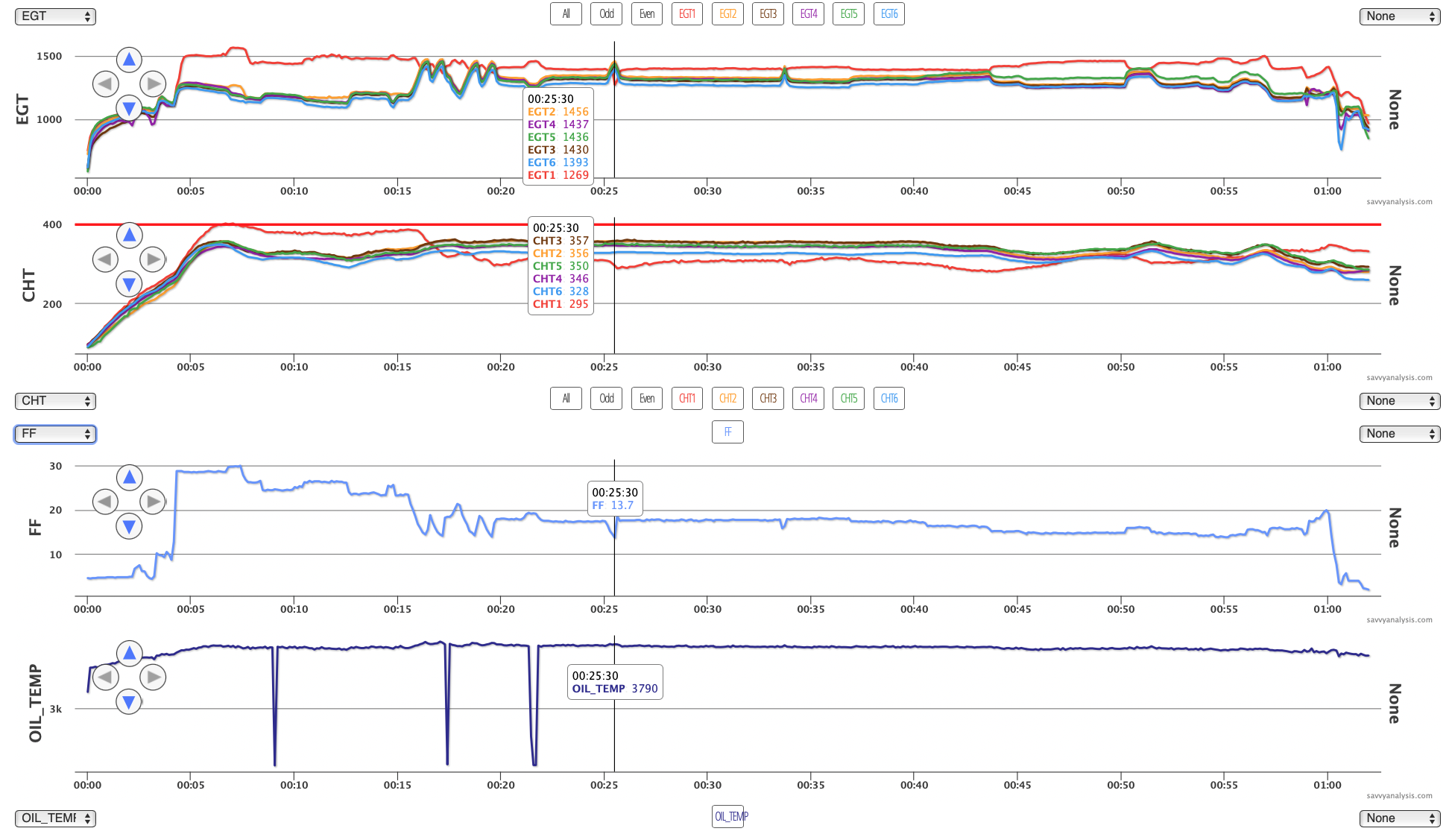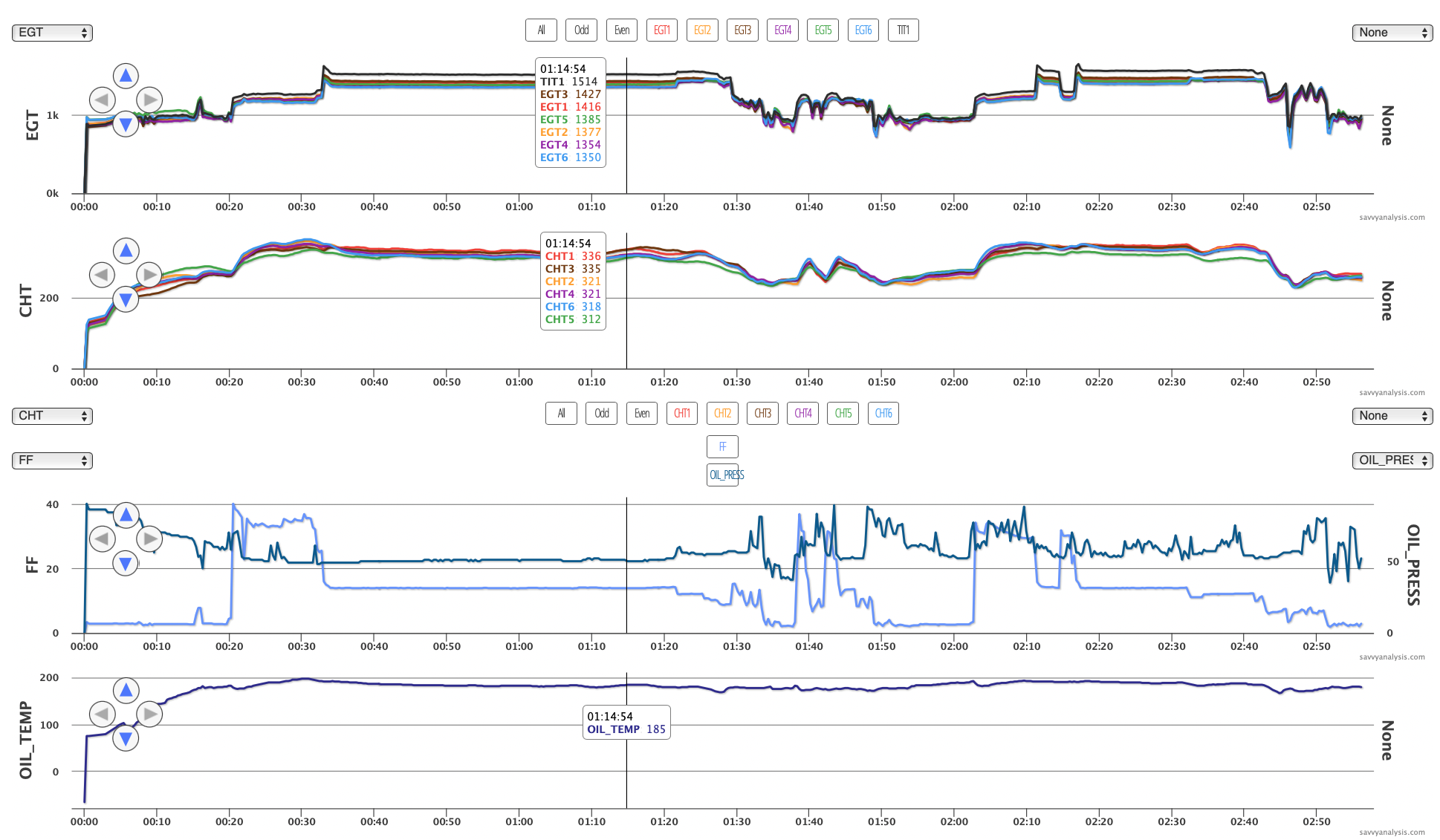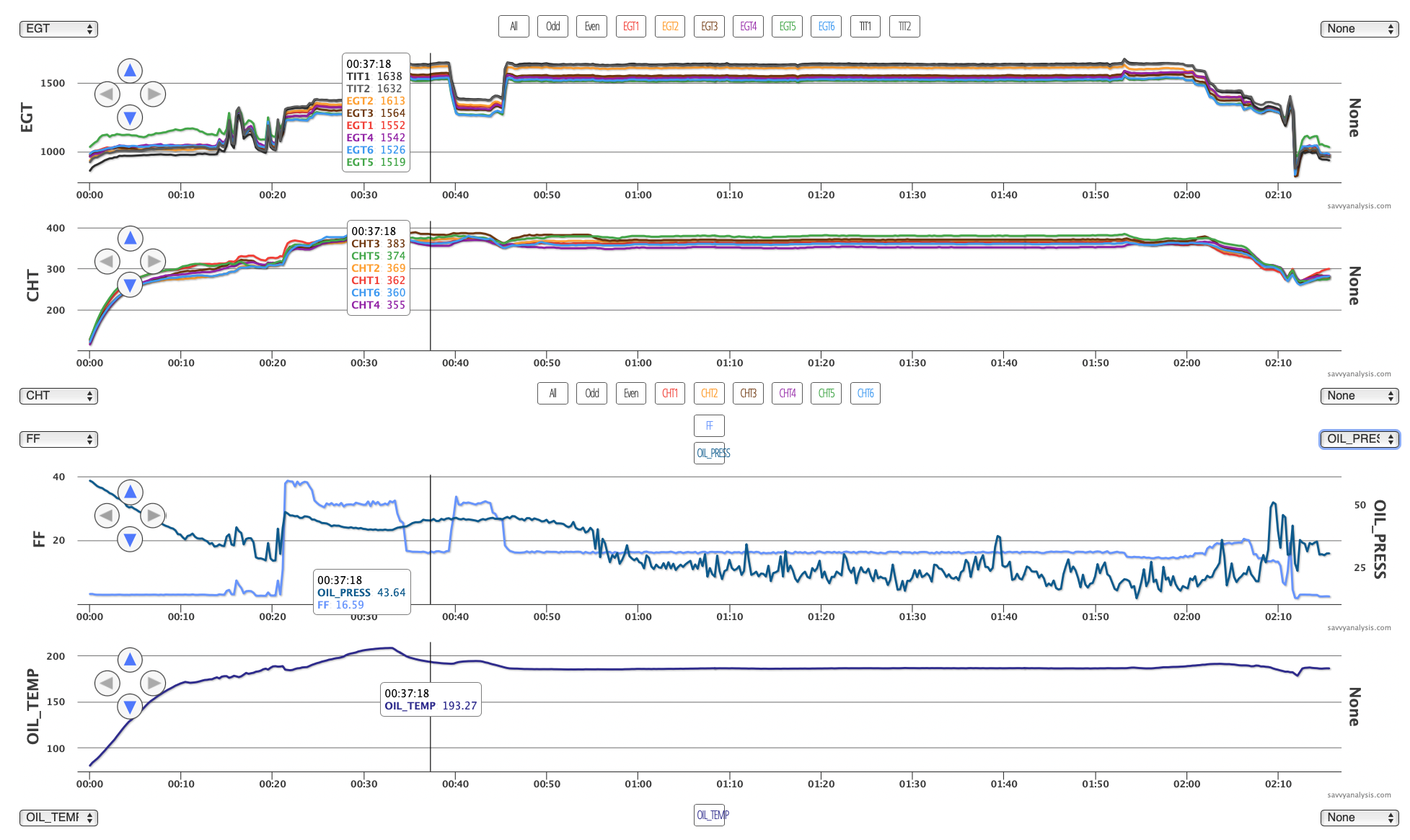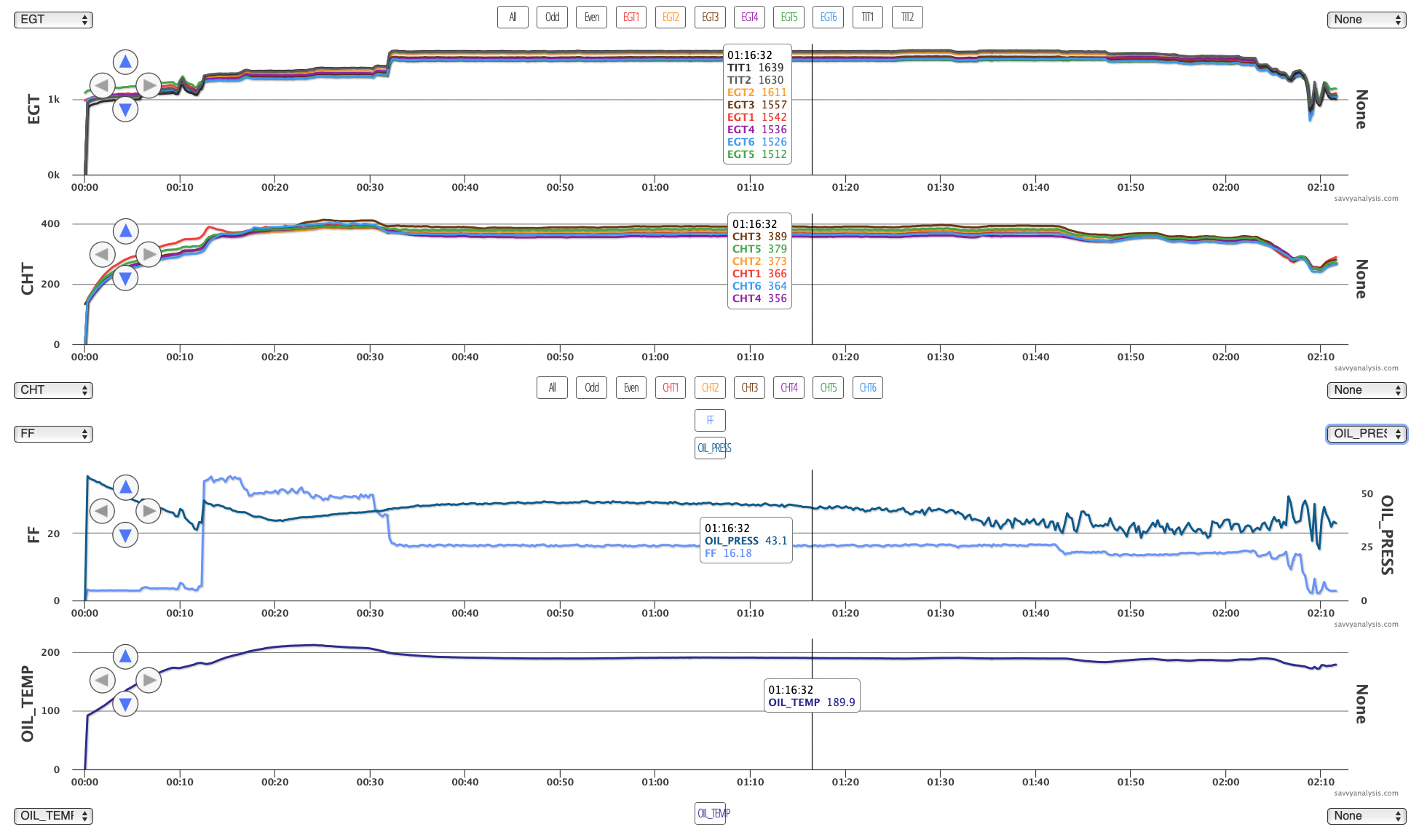Of all the anomalies that can quickly grab your attention in-flight, which one is second on your list? Because obviously a fire is at the top of the list. For me it’s a rough runner, but a change in oil pressure is right there with it. The IO-520-K in my Bellanca Viking settles in around 50 psi so it would be easy to spot if it moves either way. Fortunately, so far at least, it hasn’t – knock a wing.
Lately the analysis team has had a bunch of oil pressure and oil temp tickets. So I thought we could devote the May Puzzler to oil. Let’s not forget that it’s so much easier to recognize a loose connection or a failed probe after the flight ends and the data is uploaded. The pilots in these scenarios had to figure it out on the fly, with no guarantees that something worse wasn’t about to happen. Savvy thinks that reviewing these patterns will help pilots make more informed decisions when oil becomes turmoil. Let’s get started.
This is data from a Beech Bonanza 36 with a Continental IO-550 engine and data from an Insight G3 with a 1 sec sample rate. This is my default setting of EGTs, CHTs, FF and Oil Temp.

Let’s ignore oil temp for the moment and concentrate on the red traces of EGT and CHT 1. Everything was ok during taxi-out, then when power is applied EGT and CHT1 jump out of their shoes. Then when FF is reduced at about 16 mins, they both drop – although CHT drops more than EGT. The cursor is on a later FF reduction and if you look closely you can see EGT 1 start to flame out. The classic injector clog scenario is high EGT and CHT at max FF, then both move lower when FF is reduced. We have 3/4 of that scenario. Why doesn’t EGT 1 move lower when FF is reduced? There might be weak spark at work here too. We don’t have a LOP mag check to refer to, but there’s a pretty good case for cleaning injector 1. Since spark is suspect it wouldn’t hurt to check the harness for snug while you’re there.
Give this pilot a chit because the injector clog didn’t manifest itself until takeoff. But take the chit away again because the Y axis on the OIL TEMP rank shows it’s well over 3000º right at engine start. Those three big down spikes don’t get anywhere near normal – they drop to about 2400º. Let’s give the pilot the benefit of the doubt and say that he noticed the anomaly on the Insight, but the legacy Beech gauge was indicating normal oil temp, and both the legacy and Insight showed normal oil pressure, so he decided he had enough information to safely initiate the flight.
Comments are open. Would you take off with oil temp showing 3790º ? Would it depend on what oil pressure was indicating, or is it a dealbreaker by itself ?
Next up is data from a Cirrus SR22 with a Continental/Tornado Alley IO-550-TN and data from an Avidyne with a 6 sec sample rate. This time it’s EGT, CHT, FF and oil pressure, then oil temp.

It’s the oil pressure trace we’re interested in, but EGT, CHT and FF make it easier to spot the cruise segment. Pressure starts a little high but by the end of runup it’s right on target. No jumpiness in the taxi-out, takeoff or climb. Then the pilot pushes the nose over for cruise and the fun starts. It’s only about a 4 psi swing, which is probably enough to get your attention while flying, and probably not enough to cause to you push the “nearest” button on the GPS. Maybe the pilot realized that this started when speed and incoming air increased. The pilot doesn’t yet know that it will end again when the angle of attack changes and power is reduced for the approach – it’s easy for us to see at the 55 min mark . It always makes sense to check the connection first, and especially when we see a pattern like this.
Here’s another Cirrus SR22 with a Continental/Tornado Alley IO-550-TN and data from an Avidyne with a 6 sec sample rate. Again it’s EGT, CHT, FF and oil pressure, then oil temp.

Data shows a takeoff, about an hour in the air, a landing, looks like a go-around at 1 hr 42, then another landing, and another takeoff just after the 2 hr mark, and some more air time. Maybe it was a BFR. I put the cursor on the 50 psi mark for a reference point. In the previous example, the jumpiness started with the increase in incoming air, and ended when that changed. This example seems more like something worked its way loose and stayed loose. The worst of the swings are at 2 hrs 50 while taxiing after landing. Again, it always makes sense to check the connection first, and especially when we see a pattern like this.
Here’s data from a Cessna Corvalis 400 with a Continental TSIO-550-C and data from a Garmin 2000 with a 1 sec sample rate. Again it’s EGT, CHT, FF and oil pressure, then oil temp.

A close look shows the oil pressure trace is pretty steady in the climb, then around the cursor the movement begins, swings increase until the 55 min mark, then it’s chaos. Biggest swings are on short final. Meanwhile, oil temp is steady as she goes.
Here’s the weird thing about this one. This is data from the same airplane – previous flight.

This time it takes a while for the jumps to begin. And again the biggest swings are at the end of the data. So the last thing you’d expect is the steady trace from the first flight we looked at from this Corvalis. So is it the connection or the probe? It still makes sense to check the connection but this one might be more sinister. This might be a probe that tracks normally until it heats up. Hard to imagine a connection that tracks normally until it heats up, but can”t rule it out.
We’ll finish up with another Beech Bonanza 36 with a Continental/Tornado Alley IO-550-TN and data from a JPI 730 with a 2 sec sample rate.

To preserve the privacy of the data, I won’t show the flight map, but if I did you’d see a flight that begins over relatively flat terrain, crosses a mountainous area, then things flatten out again. The jumps happen in the rough air and go away when it’s smooth again.
Also, notice the wavy pattern in CHT 1 starting about when oil pressure starts jumping. Our best swag for that pattern is a baffle that’s slightly loose and responding to the small oscillations in pitch caused by the autopilot. We’ve made this case before and got some feedback from skeptics – but every time we ask if the autopilot was on we get a “yes.” So in the absence of a better explanation that’s our final answer and we don’t need to call a friend.
This one looks like a loose connection.